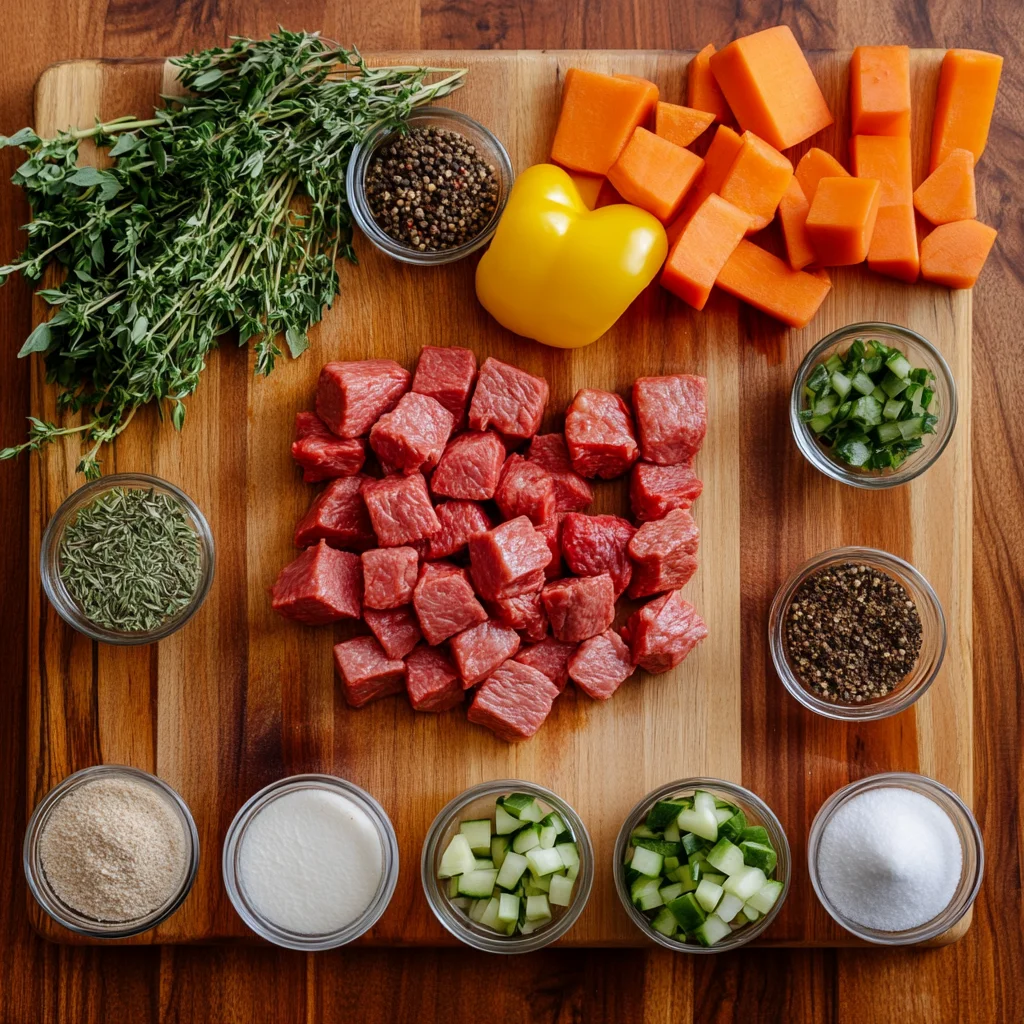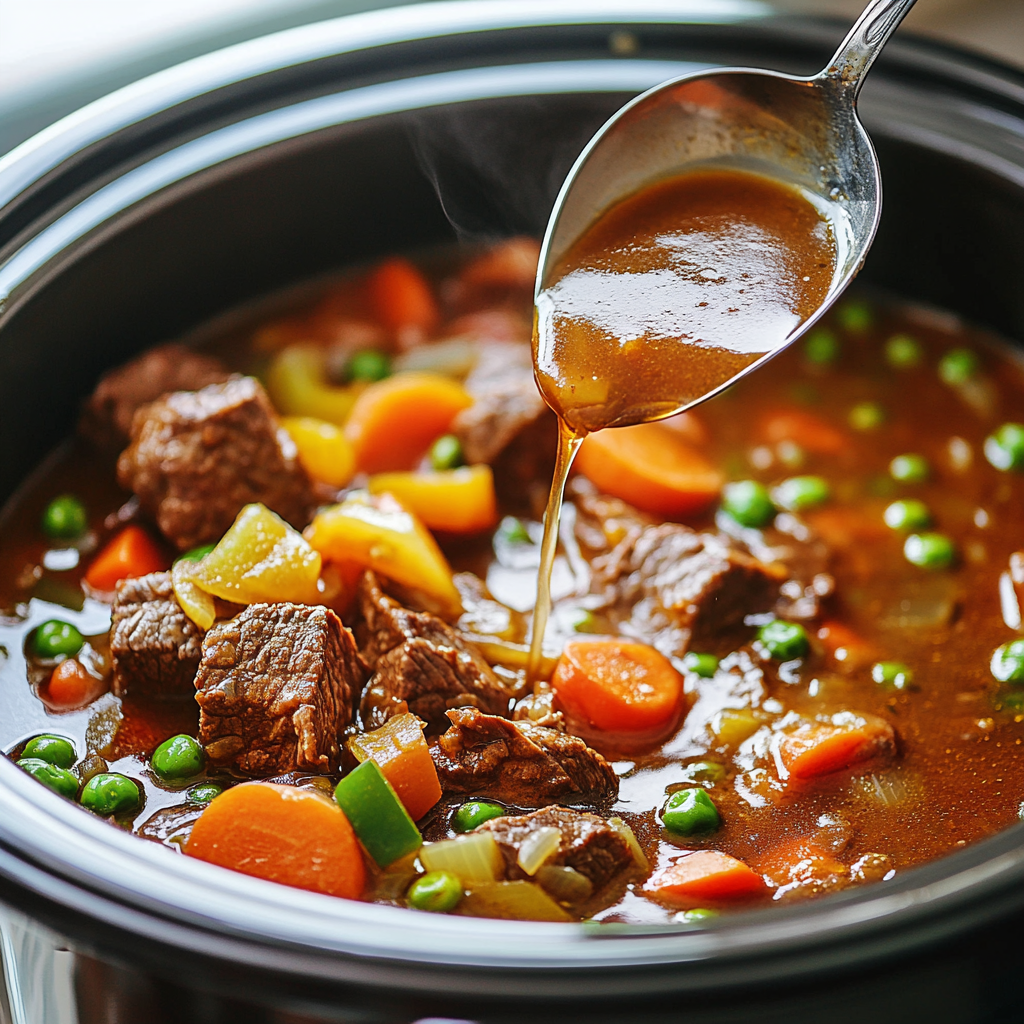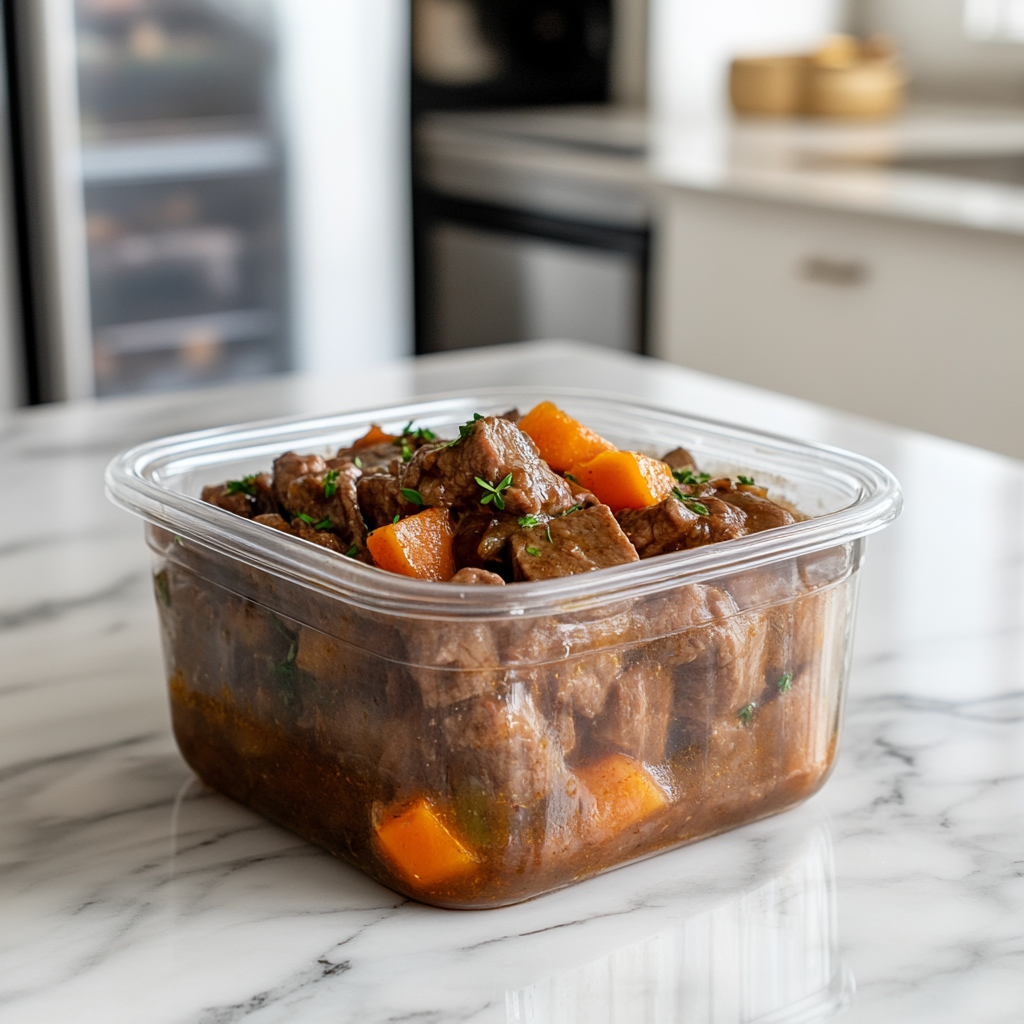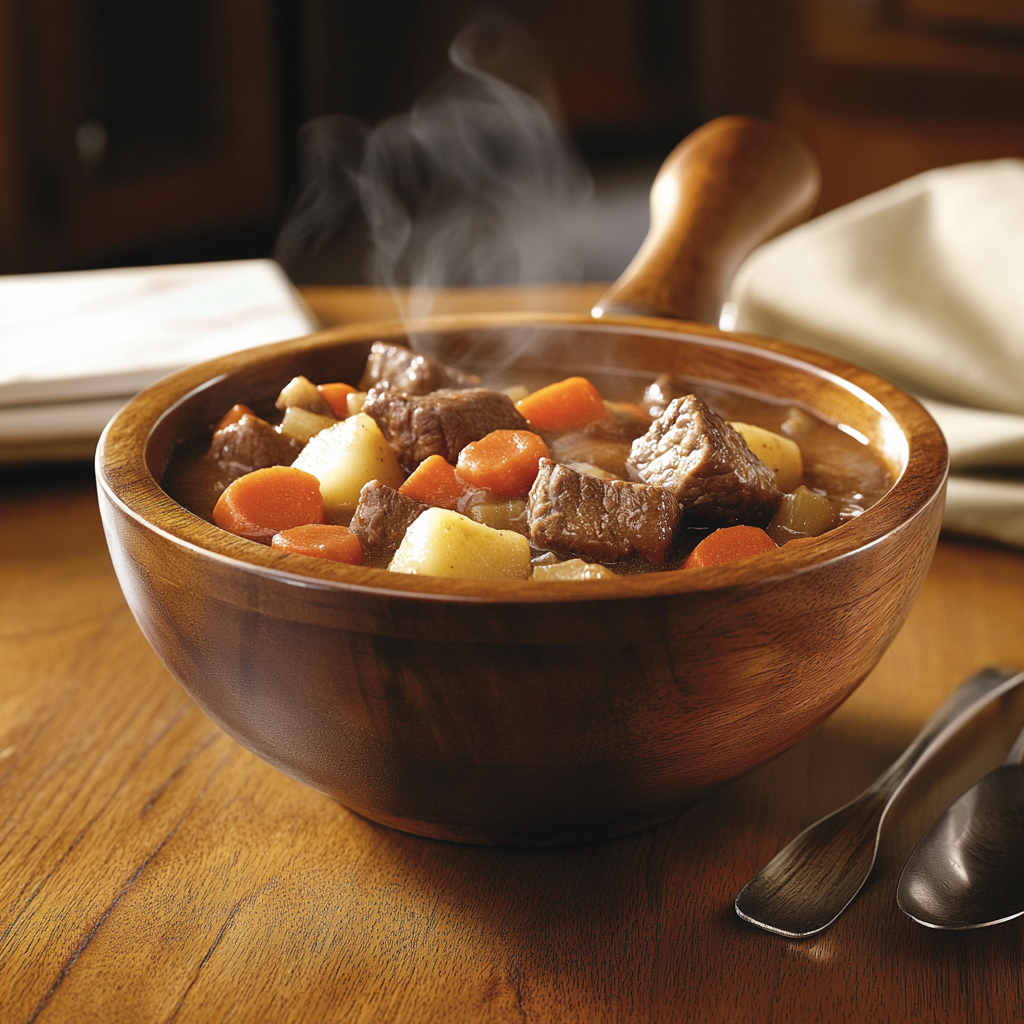Introduction
A warm, hearty bowl of beef stew is more than just a meal; it’s a memory in the making. Whether it’s a cold winter evening or a lazy Sunday afternoon, few dishes rival the satisfaction of a rich, flavorful slow cooker beef stew. Combining tender chunks of beef, a medley of vegetables, and a deeply savory broth, this dish is the epitome of comfort food.
Slow cooker beef stew is not only delicious but also incredibly convenient. With minimal effort, you can create a meal that tastes like it’s been simmering all day—because it has! Using a slow cooker allows you to set it and forget it, freeing you to tackle your day while your kitchen fills with the mouthwatering aroma of home-cooked goodness.
This recipe is designed for simplicity and flexibility. Whether you’re cooking for a family dinner or meal prepping for the week, slow cooker beef stew adapts beautifully to your schedule and preferences. Let’s dive into the details of creating this timeless dish.
Ingredients and Preparation for Slow Cooker Beef Stew
A good slow cooker beef stew begins with the right ingredients. Each component plays a crucial role in building the dish’s robust flavor and hearty texture. Whether you prefer traditional recipes or need to adjust for dietary preferences, here’s everything you need to know to prepare the perfect beef stew.
Key Ingredients for a Perfect Slow Cooker Beef Stew
- Beef: The star of the dish. Look for well-marbled cuts like chuck roast or beef stew meat. These cuts become tender and flavorful during the long, slow cooking process.
- Vegetables: A classic mix includes potatoes, carrots, celery, and onions. These hearty vegetables hold up well in a slow cooker and absorb the flavors of the broth.
- Broth or Stock: Beef broth is the base of the stew, providing a rich and savory depth. For added flavor, you can combine beef broth with a splash of red wine or Worcestershire sauce.
- Seasonings: Simple yet effective spices like garlic, bay leaves, thyme, rosemary, salt, and black pepper elevate the flavor profile.
- Thickener: Cornstarch or flour is commonly used to give the stew its signature velvety consistency.

Choosing the Right Cuts of Beef “Slow Cooker Beef Stew“
When it comes to beef stew, tougher cuts are better. Cuts like chuck roast, brisket, or bottom round contain connective tissues that break down during slow cooking, resulting in tender, melt-in-your-mouth meat. Avoid lean cuts like sirloin, which can become dry and tough after hours of cooking.
Essential Vegetables and Seasoning Blends “Slow Cooker Beef Stew“
Vegetables bring both flavor and nutrition to your stew. While potatoes, carrots, and celery are classics, feel free to get creative. Parsnips, sweet potatoes, or even mushrooms add unique twists. Seasonings like thyme, rosemary, and bay leaves provide an earthy balance to the rich broth.
Pro Tip: Fresh vs. Dried Herbs
If you’re using fresh herbs, add them towards the end of the cooking process to preserve their flavor. Dried herbs can go in at the start as their flavors develop slowly over time.
Ingredient Substitutes and Dietary Adaptations “Slow Cooker Beef Stew“
Gluten-Free Version:
Use gluten-free flour or cornstarch as a thickener, and ensure that your broth or stock is gluten-free.
Keto-Friendly Adjustments:
Swap out starchy potatoes for low-carb vegetables like cauliflower or turnips. Use a thickener like xanthan gum instead of flour or cornstarch.
Vegetarian Option
Replace the beef with hearty alternatives like portobello mushrooms, jackfruit, or seitan. Substitute beef broth with vegetable stock and adjust seasonings to maintain depth of flavor.
Preparation Tips “Slow Cooker Beef Stew“
- Trim and Cut the Beef: Trim excess fat and cut the beef into uniform cubes. This ensures even cooking.
- Chop Vegetables Evenly: To prevent overcooking, cut vegetables into chunks of similar size.
- Season Generously: Salt and pepper your beef and vegetables before cooking to lock in flavor.
- Brown the Beef (Optional): Searing the beef in a hot skillet before adding it to the slow cooker creates a rich, caramelized flavor.
Now that your ingredients are ready, it’s time to assemble and cook your beef stew. Vegetable Preparation Tips for Cooking
Step-by-Step Recipe Slow Cooker Beef Stew Guide
Creating a slow cooker beef stew is an art of layering flavors and allowing time to work its magic. Follow these steps to make a stew that’s guaranteed to impress with its tender beef, hearty vegetables, and rich, savory broth.
Preparing the Beef: Trimming, Seasoning, and Browning
- Trim the Beef: Start by removing excess fat from the beef. While some fat is good for flavor, too much can make the stew greasy.
- Cut into Uniform Pieces: Aim for 1 to 2-inch cubes. Uniformity ensures even cooking and consistent texture.
- Season Generously: Coat the beef with salt and pepper. For added depth, sprinkle with garlic powder, onion powder, or smoked paprika.
- Brown the Beef (Optional): Heat a skillet over medium-high heat, add a drizzle of oil, and sear the beef cubes on all sides. While this step is optional, it caramelizes the exterior and locks in flavor. Transfer the browned beef to the slow cooker.

Layering Ingredients for Optimal Cooking
Layering is key to ensuring every ingredient cooks to perfection. Here’s the best way to load up your slow cooker:
- Base Layer: Place root vegetables like potatoes, carrots, and parsnips at the bottom. These take the longest to cook and benefit from direct heat.
- Middle Layer: Add the browned beef cubes and any accumulated juices from the skillet.
- Top Layer: Layer softer vegetables, such as celery and onions, over the beef. This helps them retain some texture.
- Seasoning and Herbs: Sprinkle thyme, rosemary, bay leaves, and minced garlic throughout the layers for balanced flavor distribution.
Setting Your Slow Cooker Beef Stew: Tips for Time and Temperature
The beauty of a slow cooker lies in its versatility. Adjust the settings to match your schedule and desired outcome:
- Low Heat (8–10 hours): Ideal for developing deep flavors and tenderizing tougher cuts of meat.
- High Heat (4–6 hours): A quicker option when time is limited, though the flavors may not be as complex.
Adjustments for Thickness and Flavor for Slow Cooker Beef Stew
As your stew nears completion, assess its consistency and taste. Here’s how to perfect it:
- Thickening the Stew:
- Flour Slurry: Mix 2 tablespoons of flour with 3 tablespoons of cold water until smooth. Stir it into the stew during the last 30 minutes of cooking.
- Cornstarch Slurry: Combine 1 tablespoon of cornstarch with 2 tablespoons of cold water and stir it in.
- Boosting Flavor: Taste the stew and adjust with salt, pepper, or Worcestershire sauce. If the flavor is too concentrated, add a splash of water or broth.
Enhancing the Richness
A dollop of tomato paste or a splash of red wine added during cooking amplifies the stew’s savory depth.
Optional Add-Ins for Personal Touches
Customize your beef stew with these optional additions:
- Mushrooms: Add earthy richness; stir them in during the last 1–2 hours.
- Peas or Green Beans: For a pop of color and freshness, toss them in during the final 30 minutes.
- Fresh Herbs: Sprinkle chopped parsley, thyme, or chives just before serving for a vibrant finish.
With your stew simmering away, your home will soon be filled with its irresistible aroma. Ready to discover the secrets to mastering this dish? Let’s move on to expert tips!
Tips for Perfect Slow Cooker Beef Stew
Making the ultimate slow cooker beef stew is both an art and a science. Here are expert tips to elevate your dish from good to outstanding, ensuring rich flavors, perfect texture, and a visually appealing presentation.Essential Tips for Using a Slow Cooker
Common Mistakes and How to Avoid Them
- Using the Wrong Cut of Beef:
- Mistake: Choosing lean cuts like sirloin or tenderloin.
- Fix: Opt for tougher cuts like chuck roast or brisket. These cuts break down during slow cooking, becoming tender and flavorful.
- Overcrowding the Slow Cooker:
- Mistake: Filling the slow cooker to the brim.
- Fix: Leave about one inch of space at the top to allow even heat circulation.
- Skipping the Browning Step:
- Mistake: Adding raw beef directly into the slow cooker.
- Fix: Browning the meat first creates caramelized flavors that deepen the dish.
Secrets to Rich and Hearty Flavor
- Deglaze the Pan: After browning the beef, use a splash of red wine, broth, or water to scrape up the browned bits from the skillet. Pour this flavorful liquid into the slow cooker.
- Add Tomato Paste: Stir in a tablespoon or two for a subtle umami boost and richer color.
- Layer Flavors Gradually: Add stronger ingredients, like Worcestershire sauce or balsamic vinegar, sparingly and taste-test as you go.
- Incorporate Wine or Beer: A splash of dry red wine or stout beer adds complexity to the broth.
How to Balance the Broth and Vegetables for Slow Cooker Beef Stew
- Vegetable Ratios: Keep a balance between the meat and vegetables to ensure no single ingredient dominates the dish. A good rule of thumb is a 1:1 ratio of beef to vegetables.
- Broth Proportions: Start with enough broth to barely cover the ingredients. Too much liquid can dilute the flavors.
- Thickening Gradually: Use thickeners sparingly, as too much can turn the stew gummy.
Pairing Beef Stew with Sides and Garnishes
Pairing the right side dishes and garnishes with beef stew enhances the overall dining experience. Here are some ideas:
- Sides:
- Crusty Bread: Perfect for soaking up the flavorful broth.
- Mashed Potatoes: A creamy base to serve under the stew.
- Buttered Noodles: Adds a comforting, carb-rich element.
- Garnishes:
- Fresh Herbs: Sprinkle parsley, thyme, or chives for brightness.
- Grated Cheese: Parmesan or Gruyère can add a salty, nutty kick.
Storage and Reheating Tips
- Storing Leftovers: Let the stew cool completely before transferring it to an airtight container. It will last up to 4 days in the fridge or 3 months in the freezer.
- Reheating: Warm leftovers on the stovetop over low heat, stirring occasionally. Add a splash of broth or water to restore the consistency.
- Freezing Tip: Portion the stew into individual containers for quick and easy reheating.

With these tips, your slow cooker beef stew will consistently turn out flavorful and satisfying.
Frequently Asked Questions About Slow Cooker Beef Stew (FAQs)
To help you master slow cooker beef stew, here are answers to some common questions that home cooks often have. Whether you’re troubleshooting or looking for ways to customize, these FAQs cover everything you need to know.
Can I Make Beef Stew Without Browning the Meat?
Yes, you can skip the browning step if you’re short on time. However, browning adds a rich, caramelized flavor that enhances the overall taste of the stew. If you choose to skip it, consider adding ingredients like Worcestershire sauce, tomato paste, or a splash of red wine to boost the flavor of the broth.
How Do I Thicken Beef Stew If It’s Too Watery?
If your beef stew turns out too watery, here are a few ways to thicken it:
- Cornstarch Slurry: Mix 1 tablespoon of cornstarch with 2 tablespoons of cold water. Stir it into the stew and let it cook for another 15–20 minutes until thickened.
- Flour Mixture: Combine 2 tablespoons of flour with 3 tablespoons of broth from the slow cooker. Whisk until smooth and return to the stew.
- Mashed Vegetables: Mash some of the cooked potatoes or carrots and stir them back into the stew for a natural thickener.
Can I Freeze Leftover Beef Stew?
Absolutely! Slow cooker beef stew freezes well and is perfect for meal prepping. Follow these steps:
- Cool Completely: Let the stew cool to room temperature to avoid freezer burn.
- Portion: Divide the stew into individual or family-sized containers for convenience.
- Freeze: Store in an airtight container or freezer-safe bag for up to 3 months.
- Reheat: Defrost in the fridge overnight and reheat on the stovetop or microwave. Add a splash of broth if needed.
What Are the Best Sides to Serve with Beef Stew?
Beef stew pairs wonderfully with a variety of sides. Some popular options include:
- Crusty Artisan Bread: Great for dipping into the stew’s savory broth.
- Rice or Quinoa: Adds a light, fluffy base that complements the hearty stew.
- Green Salad: Balances the richness of the stew with freshness and crunch.
- Cornbread: Offers a sweet, buttery contrast to the savory flavors.
How Can I Make It Gluten-Free or Keto-Friendly?
To make beef stew gluten-free:
- Use gluten-free flour or cornstarch for thickening.
- Ensure your broth or stock does not contain added gluten.
For a keto-friendly version:
- Replace potatoes with low-carb alternatives like cauliflower, turnips, or radishes.
- Skip the flour or cornstarch and thicken with xanthan gum or simply let the broth reduce naturally.
What’s the Ideal Cooking Time for Tender Beef?
The slow cooking process tenderizes beef perfectly. Here are the recommended cooking times:
- Low Heat: 8–10 hours for deeply tender and flavorful meat.
- High Heat: 4–6 hours if you’re pressed for time.
These FAQs should clear up any doubts and help you customize your slow cooker beef stew to perfection.
Conclusion
Slow cooker beef stew is the epitome of comfort food, combining tender chunks of beef, hearty vegetables, and a savory, flavorful broth. This dish not only warms the body but also feeds the soul, making it a timeless favorite for families and gatherings. With the ease of slow cooking, you can enjoy a hands-off approach while achieving rich, deeply developed flavors that taste like you’ve spent hours in the kitchen.
By carefully selecting the right cuts of beef, layering fresh vegetables, and seasoning thoughtfully, you can create a stew that is both nourishing and satisfying. Whether you’re a seasoned cook or a beginner, the simplicity and flexibility of this recipe make it an essential addition to your culinary repertoire.
Embrace the creative possibilities by adding your own twists, whether it’s incorporating unique vegetables, experimenting with different seasonings, or serving it alongside your favorite sides. And with the ability to adapt for dietary preferences—like gluten-free or keto-friendly options—this recipe is as versatile as it is delicious.
So, grab your slow cooker and gather your ingredients. Let the aromas of this hearty stew fill your home, and prepare to delight your family and friends with a dish that’s as comforting as a warm hug. There’s nothing quite like slow cooker beef stew—simple, satisfying, and unforgettable.

